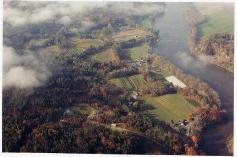|
--What are Agricultural Resources?
--What does the map of Plainfield Agriculture show?
--Why are agricultural resources important?
--What threatens agricultural resources?
--What do we need to know about agriculture in Plainfield?
--What is next?
What are Agricultural Resources?
Important agricultural soils include "prime farmland" and "farmland of
statewide importance". As defined by the US Natural Resource Conservation Service
(NRCS), "prime farmland" is the land best suited to produce food, feed, forage, fiber, and oilseed crops. "Farmland of statewide importance" has many of the same attributes of "prime farmland." Because good agricultural soils are relative scarce in New Hampshire, both of these soil types are of nearly equal importance and value. “Farmland of local importance” is land that does not meet either of the above categories but is important to the local farming economy. These can be areas adjacent to prime soils or flat areas that are well suited to cropping.
What does the map show?
The Agricultural Resources Map (636kb) that Plainfield contains several significant concentrations of important farmland soils. These areas are widely scattered, with concentrations found along the Connecticut River, along Black Hill Road, along Blood Brook near the Plainfield School, in the Jenney Road/True Road area and in Plainfield Village. The lands along the Connecticut River show the highest occurrence of prime farmland soils in the Town and are typically well drained and near optimal ph levels making them suitable to almost all types of crops. The NRCS has also evaluated soils according to their suitability for timber production. In general, soils that are suitable for growing crops are suitable for growing trees as well. Thus, the farmland soils depicted on the map are also suitable for timber stands. Appendix A provides summary information about important agricultural soils in the Town of Plainfield.
Why are agricultural resources important?
Plainfield has a rich agricultural history and tradition that continues today. Plainfield, like other communities in the Upper Valley Region of New Hampshire, has seen the number of farms diminish over the past 50-years; however, unlike many of the towns in the region, Plainfield retains a vibrant core of diverse commercial agricultural enterprises and a growing number of “hobby” farms that generate a portion of household income, food, fiber and enjoyment. Appendix B lists current Plainfield farms.
- Prime farmland and farmland of statewide importance produce the highest yields with minimal inputs of energy and economic resources, and farming it results in the least damage to the environment.
- Prime farmland and farmland of statewide importance can be farmed continuously or nearly continuously without degradation of the environment.
- Prime farmland and farmland of statewide importance produce food and fiber for local and regional markets.
- Farmland provides open space and scenic resources which are identified as Cornerstones of our community.
- Farmland provides important groundwater recharge areas.
- Farmland provides wildlife habitat.
- Farmland provides important economic benefits, especially to the local and regional economy.
What threatens agricultural resources?
The primary threat to this resource in most communities including Plainfield is development. Once development occurs on an important soil type the development site cannot be used for agriculture ever again. The quality soil is often removed from the site and replaced by buildings driveways and septic systems. In addition, the prime soils surrounding the construction sites are often rendered unusable due to the fragmentation of the site caused by the placement of the buildings and associated amenities.
Existing state laws do not forbid development on prime and important soils. There have been several programs offered by the State to protect valuable agricultural land through the purchase of development rights. These have focused on lands considered most at risk. Plainfield has benefited from this program and the Riverview Farm property was protected.
What do we need to know?
Any additional analysis will require the accumulation of more specific data about the Town’s farmland soil areas. We need to accurately map the prime farmlands which are actively farmed as well as the inactive prime and important soil areas which have not been developed. In addition, co-occurance maps should be developed which identify farmlands that overlap or are adjacent to other resources such as aquifers, surface waters and critical habitats so that they can be given priority in any conservation efforts.
What is next?
- Educate people on the importance of this resource and how smart growth principles can be used to protect it for future generations.
- Use GIS mapping to identify active and inactive areas of prime and important farmland soils which have not been developed.
- Work with Natural Resource Conservation Service (NRCS) to assign values according to soil type, use, size, etc., and rank these areas taking into account other factors such as threat of development and other resource values (i.e.: proximity to an aquifer, wildlife habitat, etc.). Use this information to designate “resource envelopes” which identify areas of special importance.
- Seek funding to purchase development rights on the highest ranked prime farmland in order to preserve these areas.
- Evaluate Town zoning, building, sub-division and other regulations in terms of their impact on agriculture including the extent to which they do or should:
- Promote “conservation subdivisions”
- Require that development take place out of high quality agricultural “resource envelopes”.
- Allow the trading of development rights to protect quality farmland in exchange for higher density in more appropriate locations.
- Prevent unreasonable barriers to agricultural uses.
- Promote a vibrant local agricultural economy to help keep farms profitable thus reducing the threat of development on productive fields.
|



